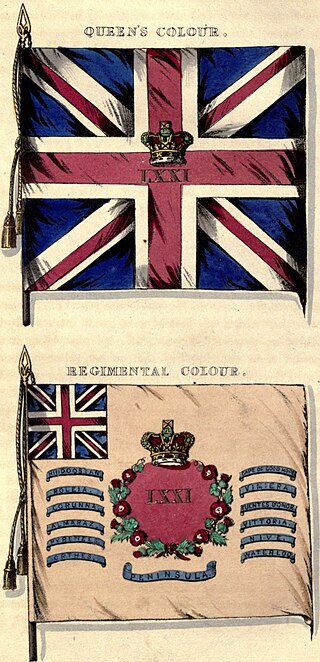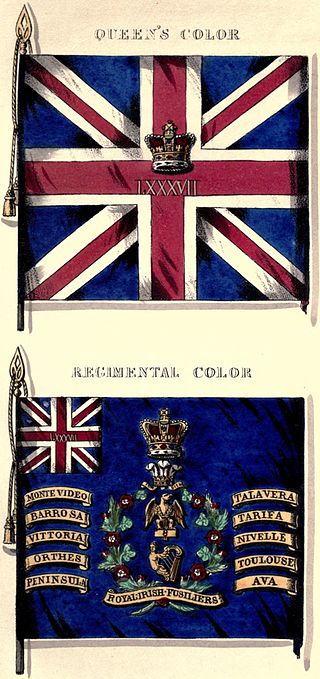The 96th Regiment of Foot was a British Army regiment, raised in 1798. Under the Childers reforms it amalgamated with the 63rd Regiment of Foot to form the Manchester Regiment.

The Buffs (Royal East Kent Regiment), formerly the 3rd Regiment of Foot, was a line infantry regiment of the British Army traditionally raised in the English county of Kent and garrisoned at Canterbury. It had a history dating back to 1572 and was one of the oldest regiments in the British Army, being third in order of precedence (ranked as the 3rd Regiment of the line). The regiment provided distinguished service over a period of almost four hundred years accumulating one hundred and sixteen battle honours. In 1881, under the Childers Reforms, it was known as the Buffs (East Kent Regiment) and later, on 3 June 1935, was renamed the Buffs (Royal East Kent Regiment).

The 88th Regiment of Foot (Connaught Rangers) was an infantry Regiment of the British Army, raised in 1793. Under the Childers Reforms it amalgamated with the 94th Regiment of Foot to form the Connaught Rangers in 1881.
The 89th Regiment of Foot was a regiment of the British Army, raised on 3 December 1793. Under the Childers Reforms the regiment amalgamated with the 87th Regiment of Foot to form the Princess Victoria's in 1881.

The 50th Regiment of Foot was an infantry regiment of the British Army, raised in 1755. Under the Childers Reforms it amalgamated with the 97th Regiment of Foot to form the Queen's Own Royal West Kent Regiment in 1881.

The 92nd Regiment of Foot was a British Army infantry regiment, raised in 1794. Under the Childers Reforms it amalgamated with the 75th (Stirlingshire) Regiment of Foot to form the Gordon Highlanders in 1881.
The 38th Regiment of Foot was an infantry regiment of the British Army, raised in 1705. Under the Childers Reforms it amalgamated with the 80th Regiment of Foot to form the South Staffordshire Regiment in 1881.

The 71st Regiment of Foot was a Highland regiment in the British Army, raised in 1777. Under the Childers Reforms it amalgamated with the 74th (Highland) Regiment of Foot to become the 1st Battalion, Highland Light Infantry in 1881.
The 91st Regiment of Foot was a Line Regiment of the British Army, raised in 1794. Under the Childers Reforms it amalgamated with the 93rd Regiment of Foot to form the Argyll and Sutherland Highlanders in 1881.
The 77th Regiment of Foot was a line regiment of the British Army, raised in 1787. Under the Childers Reforms it amalgamated with the 57th Regiment of Foot to form the Duke of Cambridge's Own in 1881.

The 95th (Derbyshire) Regiment of Foot was a British Army infantry regiment, raised in 1823. Under the Childers Reforms, it amalgamated with the 45th (Nottinghamshire) Regiment of Foot to form the Sherwood Foresters in 1881.

The 67th Regiment of Foot was a line infantry regiment of the British Army, raised in 1756. Under the Childers Reforms it amalgamated with the 37th Regiment of Foot to form the Hampshire Regiment in 1881.
The 41st (Welch) Regiment of Foot was an infantry regiment of the British Army, raised in 1719. Under the Childers Reforms it amalgamated with the 69th Regiment of Foot to form the Welch Regiment in 1881.

The 46th Regiment of Foot was an infantry regiment of the British Army, raised in 1741. Under the Childers Reforms it amalgamated with the 32nd (Cornwall) Regiment of Foot to form the Duke of Cornwall's Light Infantry in 1881, becoming the 2nd Battalion of the new regiment.

The 87th Regiment of Foot was an infantry regiment of the British Army, raised in 1793. Under the Childers Reforms it amalgamated with the 89th Regiment of Foot to form the Princess Victoria's in 1881.
The 58th (Rutlandshire) Regiment of Foot was a British Army line infantry regiment, raised in 1755. Under the Childers Reforms it amalgamated with the 48th (Northamptonshire) Regiment of Foot to form the Northamptonshire Regiment in 1881.
The 62nd (Wiltshire) Regiment of Foot was an infantry regiment of the British Army, which was raised in 1756 and saw service through the eighteenth and nineteenth centuries. Under the Childers Reforms it amalgamated with the 99th (Lanarkshire) Regiment of Foot to form the Wiltshire Regiment in 1881.
The 74th (Highland) Regiment of Foot was a British Army line infantry regiment, raised in 1787. Under the Childers Reforms it amalgamated with the 71st (Highland) Regiment of Foot to form the Highland Light Infantry in 1881.
The 85th Regiment of Foot was a British Army line infantry regiment, raised in 1793. Under the Childers Reforms it amalgamated with the 53rd (Shropshire) Regiment of Foot to form the King's Shropshire Light Infantry in 1881.

The 90th Perthshire Light Infantry was a Scottish light infantry regiment of the British Army, raised in 1794. Under the Childers Reforms it amalgamated with the 26th (Cameronian) Regiment of Foot to form the Cameronians in 1881.













